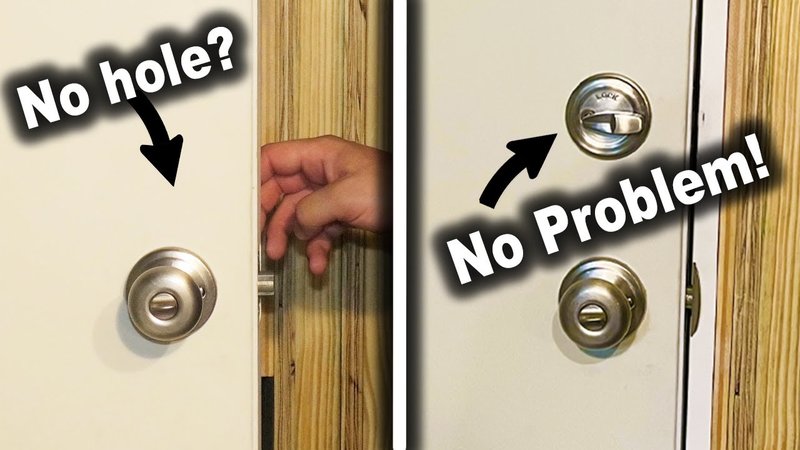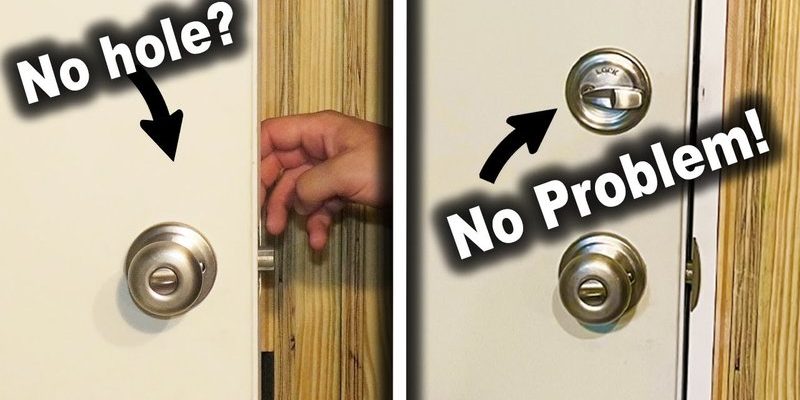
That’s where a simple hand tool comes in handy: a small file. Using a file to shape a deadbolt latch bolt tip might sound a bit DIY (or even intimidating), but honestly, it’s just like sanding down a splintered piece of wood—only on a much smaller scale. Whether you’re dealing with a Schlage, Kwikset, Yale, or another brand, the idea is the same. Smoothing out that latch bolt tip can be a quick fix for a sticky deadbolt, and you don’t need to be a pro locksmith to pull it off.
Let’s break down what’s actually happening inside your lock, what kind of file you’ll want to use, and every step you need to safely smooth out your latch bolt tip. You’ll see it’s not just about strength—it’s about precision and patience.
Why a Deadbolt Latch Bolt Tip Needs Shaping
You might be wondering why you’d ever need to shape the tip of a deadbolt latch bolt in the first place. Well, here’s the thing: even high-quality deadbolt brands like Schlage and Kwikset can start sticking after years of use. Dings, scratches, or a slight bend at the tip of the latch bolt are all it takes to create friction—making the lock hard to operate or impossible to fully engage.
Sometimes, a new door alignment, a coat of thick paint, or even just a factory imperfection can leave the latch bolt with a sharp edge or uneven surface. When that happens, it scrapes against the strike plate or catches on the edge of the hole in the door frame. It’s a tiny flaw, but it causes big headaches every time you lock or unlock.
The beauty of shaping with a small file? You’re not replacing parts or unscrewing your whole lock. Instead, you’re restoring that smooth, angled face to the bolt tip so it slides in easily—like sharpening a pencil so it writes cleanly again. If you’ve tried lubricants, adjusted the strike plate, and even reset or paired a high-tech smart lock without luck, a file may be the answer you’ve missed.
Choosing the Right Small File for the Job
Not all files are created equal, and using the wrong one can make things worse. For shaping a deadbolt latch bolt tip, you’ll want a small, fine-toothed file—something that offers control and precision over brute force. Larger files are awkward for detail work; you could end up scratching the rest of the mechanism or making the edges more jagged.
The best option? A set of needle files or a mini flat file. You’ll often find these in hobby kits or locksmith tool sets. A triangular file can help if your bolt tip has an odd angle, but honestly, a flat file is versatile enough for most jobs.
- Needle files: These are slim, pointed, and come in different shapes—perfect for tight spots.
- Mini flat file: Offers a broader surface, which helps smooth out the main face of the latch.
- Diamond-coated file: This type can handle tougher, hardened steel bolts but costs a bit more.
No need for an expensive tool—just something small enough to give you control. If you’ve never used a file before, don’t worry. The technique is more about gentle strokes than aggressive sawing.
Prepping the Deadbolt and Work Area
Before you start filing, there are a few things you should do to make the job smoother and safer. First, unlock your deadbolt and open the door wide. You’ll want clear access to the latch bolt tip without the door swinging shut on your fingers.
If you’re working on a smart lock, disconnect the battery or any power supply as a safety measure. For basic key-based deadbolts like Kwikset or Schlage, there’s no need to worry about electronics. Lay down a cloth or towel to catch any metal filings—they’re too small to see but can scratch your floors or stick to your socks.
Check the bolt tip: If it’s covered in dirt or grime, wipe it clean with a soft cloth. If there’s old lubricant caked on, remove it with a dab of rubbing alcohol. You want a clear view of what you’re working on so you don’t end up filing the wrong spot. And if you’re someone who likes to double-check everything (no shame in that), snap a photo of the bolt before you start, just for reference.
Last but not least, make sure you have good lighting. It’s hard to see tiny edges or rough spots if you’re working in a dim hallway. A bright flashlight or work lamp helps you catch every imperfection.
How to File the Deadbolt Latch Bolt Tip Safely
Here comes the careful part. The goal isn’t to remove a lot of metal—it’s to smooth out burrs, round off sharp corners, and gently shape the tip so it glides into the strike plate without catching.
- Hold the file like a pencil, using your dominant hand for control.
- Rest your other hand on the door or frame to steady yourself.
- Use light, even strokes—always filing in one direction, not back and forth like sawing wood.
- Focus on the tip and leading edges of the latch bolt. You want a gentle slope or chamfer, not a blunt square face.
Keep checking your progress every 6–8 strokes. Run your finger gently over the bolt tip (watch for tiny metal shavings) to see if it feels smoother. If you spot any deep nicks or high spots, work them down gradually—don’t try to “fix” everything in one go. Think of it as polishing more than grinding.
If you’re working on a smart lock or a universal multi-brand latch, check for any plastic or electronic parts nearby. Always file metal, not plastic or wiring. When in doubt, stop and reassess—you can’t put metal back once it’s gone.
Testing and Fine-Tuning the Bolt Fit
Once you’re happy with the newly-shaped tip, it’s time to test your work. Close the door gently and try locking and unlocking the deadbolt several times. Don’t force it—just see if it moves more smoothly than before.
Sometimes, you’ll realize you need a little more smoothing. That’s totally normal. Open the door and inspect the bolt tip again. Look for shiny spots—that’s where it’s rubbing against the strike plate. File those areas with a few more light strokes and retest.
It’s a bit like syncing a new universal remote: sometimes you need to try, reset, and adjust before everything works just right. Patience is key. If, after shaping, your deadbolt still snags, check that the strike plate is aligned and the hole in the door frame is large enough. Sometimes the issue is a mix of bolt and frame problems.
Pro tip: Once everything feels right, wipe the bolt with a clean cloth to remove any dust, then apply a tiny dab of graphite or silicone-based lubricant. This helps keep things running smoothly and prevents future sticking.
Common Issues and How to Troubleshoot Them
Even after shaping the bolt tip, you might hit a few snags. Here’s what to watch for:
- Bolt still sticking: The strike plate could be misaligned, or there’s a burr you missed. Re-check your work and look inside the door frame hole for obstructions.
- Deadbolt hard to turn: File may have left rough, uneven edges—go back and smooth with finer strokes. For smart locks, make sure the battery isn’t low or the code hasn’t reset itself after disassembly.
- Universal or multi-brand deadbolts: Some models use different materials for the bolt tip. If steel feels too tough for your file, try a diamond-coated file or consult your brand’s troubleshooting guide.
- Gaps or misfit: If the bolt tip is now too rounded, it may not fully engage with the strike plate. You want a balance—not too sharp, not too blunt.
Remember: The key here is small, steady improvements—not radical changes. If you’re ever unsure or the lock feels unsafe, don’t hesitate to call a professional locksmith.
Comparing Shaping with a File to Other Fixes
You might be thinking, “Isn’t there an easier way?” The truth is, there are other solutions, but using a file is one of the least invasive (and least expensive) ways to get your deadbolt working properly.
Let’s compare a few alternatives:
| Method | Pros | Cons |
| Lubricant Spray | Quick, easy, no tools needed | Doesn’t fix a rough or damaged bolt tip; temporary fix |
| Adjust Strike Plate | Can solve alignment issues; no filing involved | Requires drilling or moving hardware; may not fix bolt imperfections |
| Replace Deadbolt | Solves all hardware issues; fresh start | Costs money; more work; you’ll need to re-code or pair smart locks |
| File the Bolt | Precise, cheap, fixes most minor sticking immediately | Requires care and patience; not for major damage |
So, if your deadbolt issue is just a rough tip—and you’re not ready to reset, re-code, or pair a whole new lock—grabbing a file is often the best first move.
Keeping Your Deadbolt Working Smoothly After Filing
Once you’ve shaped the latch bolt tip, it’s important to keep things in top shape. Deadbolts last longer and work better with a little routine care—think of it like regular oil changes for your car.
- Clean the bolt: Wipe it down every few months to remove dust and grime.
- Apply lubricant: Use graphite or silicone (never WD-40—it gums up over time) to keep things moving smoothly.
- Check alignment: If you ever move or rehang the door, make sure the bolt still lines up with the strike plate.
- Reset or sync smart locks: Batteries and electronics can act up if you’ve removed parts. Always follow your brand’s pairing or troubleshooting steps.
A little maintenance goes a long way. You shouldn’t need to file the bolt tip often—maybe only once in a blue moon. But if you ever feel that grinding or sticking, you’ll know exactly where to start.
When to Call in a Locksmith
Let me be honest: most deadbolt problems can be solved with patience, a steady hand, and a small file. But sometimes, there are deeper issues—like a bent bolt, warped door, or electrical trouble with a smart lock—that go beyond simple DIY.
If you’ve tried shaping and the lock still doesn’t work—or if you spot cracks, deep gouges, or broken components—bring in a pro. Locksmiths have the skills and specialized tools to reshape, reset, or replace parts safely. For smart locks, they also know the ins and outs of code resets, battery replacements, and pairing issues.
Knowing when to ask for help isn’t failure—it’s the best way to keep your home secure and avoid making the issue worse.
Sometimes, a tricky lockout or persistent problem is a sign of a bigger issue. Don’t hesitate to get an expert opinion if something feels off.
Wrapping Up: Smoother Locks, Happier Doors
Taming a sticky deadbolt doesn’t have to mean expensive repairs or brand-new hardware. With the right small file and a little patience, you can shape that latch bolt tip and get your lock working as it should. It’s a simple fix that puts control back in your hands—no locksmith required (unless things get hairy).
Whether you use a Schlage, Kwikset, Yale, or a universal smart lock, shaping the bolt tip is about removing just enough metal so the bolt slides in effortlessly. Along the way, you’ll save time, money, and a lot of frustration every time you lock up.
So next time your deadbolt acts up, grab that file with confidence. A few careful strokes can make all the difference—and keep your doors clicking smoothly for years to come.
